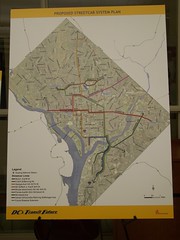Map: Proposed DC Streetcar System Plan
Last night I went to one of the DC Dept. of Transportation open houses on the streetcar plan. It's exciting that the city has renewed its commitment to the introduction of streetcars to the city's transportation options.
At the same time, it is somewhat disappointing that the streetcar planning goals seem to be incredibly parochial, focused on "serving DC residents" almost exclusively "because DC residents for the most part will be paying for the system."
In short, the City isn't exhibiting much in the way of a regional perspective. This matters because if it were, and surface fixed rail transportation options were explored more expansively, then it is likely that in some instances, regional routes, such as from Rockville Pike into DC or said another way, from Wisconsin Avenue in DC up into Montgomery County, could justify light rail as opposed to streetcars, and light rail needs a heavier road bed (even though streetcars and light rail vehicles can be interoperable).
The point that streetcars should be "for us by us" because "we're paying for it" is an incredibly limited view. Interdicting commuter traffic in and out of the city upon DC streets benefits residents.
Residents pay for this in terms of reduced quality of life, traffic engorged neighborhoods, and increased travel times.

This poster board exhibited at the DC Streetcar open house lists "DC-specific" transit services, excluding the subway system as it is a metropolitan service. However, at the core of the city, 29 subway stations provide a kind of "intra-city" transportation subnetwork that serves the city "moncentrically" while simultaneously serving the metropolitan region within the polycentric design of the overall subway network.
So reducing commuting traffic is a benefit, and justifies more expansive thinking about planning for surface-based fixed-rail transit.
The reality is that the city's competitive advantage rests upon transportation efficiencies. And the city must manage transportation for a number of audiences:
1. Residents;
2. People who work in the city (residents and non-residents);
3. Businesses and other organizations choosing to locate and maintain a space to conduct businesses (residents and non-residents);
4. Other investors (residents and non-residents)
5. People who attend school in the city (residents and non-residents);
6. People who visit the city (in-region residents, out-of-region visitors) for work, entertainment, or vacation;
7. People who shop (residents and non-residents).
8. Businesses that serve the various residents, offices, and buildings and use vehicles in order to do so.
The objective of the Department of Transportation should be to manage the needs and demands and preferences of each of these various audience groupings, working to optimize the transportation system and infrastructure towards efficiency.
Just because DC residents "pay" for streetcars doesn't mean that the transit system should be managed only to "benefit" DC residents--whatever that means.
The continued prominence and value of the city is dependent on a much more expansive view of transportation. The scope of the streetcar program needs to be reassessed, reexamined and expanded.
Labels: transportation planning




0 Comments:
Post a Comment
<< Home